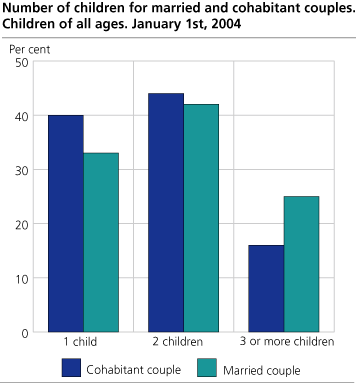Content
Published:
This is an archived release.
Less married couples with children at home
The number of married couples with children living at home has decreased with 5 700 to 474 500 from last year while the number of married couples without children living at home has increased with 3 000 to 354 700 in the same period. The number of cohabitating couples has increased with 3 500 to 103 300.
The reduction of the number of married couples with children living at home is caused by the increase of cohabitation. The mean age for married persons is getting higher, and older couples have less children living at home. We have observed this trend since we published figures for cohabitant couples with at least a child together for the first time in 1987, for children of all ages.
Having two children is the most popular for cohabitant couples with children together and married couples with children. Almost a half of cohabitant couples with children together, 44 per cent, had two children. And 42 per cent of the married couples with children had two of them.
The percentage of cohabitant couples with one child is higher than for married couples, and there are more married couples with three or more children than cohabitant couples. This is because cohabitant couples are younger and many of them marry after a period of cohabitation.
The percentage of couples (married and cohabitating) with one child is highest in Oslo, and the percentage of couples with three or more children is highest in Sogn og Fjordane.
Cohabitants have younger children
2 000 cohabitating couples and 130 000 married couples have children at home under 18 years. This is because cohabitating couples are younger, cohabitation is relative new and for many couples it represents a period before marriage.
More cohabitant couples with three or more children
Statistics Norway has produced statistics for cohabitant couples with at least a child together since 1989, for children under 18 years. In this period the number of cohabitant couples with three or more children has increased from 3 000 to 14 000. The number of married couples with three or more children has been more stable with a top of 84 000 in 2000 and it has decreased to 82 000 the last years.
Low increase of registered partners
The amount of registered partners with and without children increased with 30 to 1 166. This is the lowest increase in the last years. The number of partners with children increased to 97. This figure has doubled in two years.
Family statistics
We cannot identify cohabitant couples without children together. That is the reason why we only produce statistics for married couples with and without children at home and cohabitating couples with at least a child at home. The family types we cannot identify are singles, cohabitating couples without children together, mother with children and father with children. This represents 1 583 000 persons.
Children in family statistics are children of any age registered living at home.
Other sources
You can find more information about families, households and children in Norway in our website: http://www.ssb.no/english/subjects/02/01/20/
And in these links you can get more information about births , marriages and divorces .
Tables:
- Table 1 Families, by type of family. Children of all ages. 1960-2004
- Table 2 Families, by type of family. Children under 18 years of age. 1974-2004
- Table 3 Persons, by type of family. 1 January 2004
- Table 4 Families, by type of family and the number of children living at home. Children of all ages. 1 January 2004
- Table 5 Families, by type of family and number of children living at home. Children under 18 years of age. 1 January 2004
- Table 6 Families, by type of family and the number of children living at home under 18 years of age. 1974- 2004
Contact
-
Statistics Norway's Information Centre
E-mail: informasjon@ssb.no
tel.: (+47) 21 09 46 42
-
Espen Andersen
E-mail: espen.andersen@ssb.no
tel.: (+47) 92 61 00 46
-
Ane Margrete Tømmerås
E-mail: ane.tommeras@ssb.no
tel.: (+47) 91 99 29 62
-
Oppdrag befolkningsstatistikk
E-mail: befolkning@ssb.no


